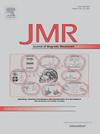Rapid flow characterization measurements using a modified CPMG measurement with incremented echo times, phase cycling and filtering
IF 1.9
3区 化学
Q3 BIOCHEMICAL RESEARCH METHODS
引用次数: 0
Abstract
We recently demonstrated a magnetic resonance methodology for measuring and characterizing various pipe flows, using a series of individually-acquired spin echoes at different . The key advantage of our approach lies in the simplicity of the experiment, MR hardware, and data processing. However, acquiring each spin echo separately results in prolonged measurement times. To address this, we employ an echo-train approach to acquire the series of variable spin echoes. By incrementing CPMG echo pulse spacings within the echo train and implementing a four-step phase cycling scheme to suppress coherence pathway effects, we obtain the same echo phase and magnitude response to flow as a function of as in our original method, without requiring individual echo acquisitions. This new approach significantly reduces the number of required experiments, shortening measurement time by a factor of , where is the number of utilized echoes per echo train. Our phase cycling strategy, combined with incremented pulse spacings, enables in our benchtop flow measurement. Validation experiments with Newtonian and shear-thinning fluids confirm that the new echo-train technique yields results consistent with the original approach of acquiring each spin echo separately.

快速流动特性测量使用改进的CPMG测量增加回声时间,相位循环和滤波
我们最近展示了一种磁共振方法,用于测量和表征各种管道流动,使用不同τ下的一系列单独获得的自旋回波。该方法的主要优势在于实验、MR硬件和数据处理的简单性。然而,单独获取每个自旋回波会导致测量时间延长。为了解决这个问题,我们采用回波序列方法来获取一系列变τ自旋回波。通过在回波序列中增加CPMG回波脉冲间隔,并实施四步相位循环方案来抑制相干路径效应,我们获得了与原始方法相同的回波相位和振幅响应,作为τ2的函数,而不需要单独的回波采集。这种新方法显著减少了所需的实验次数,将测量时间缩短了1/N,其中N为每个回波序列所利用的回波数。我们的相位循环策略,结合增量脉冲间隔,使我们的台式流量测量N=3。牛顿流体和剪切变稀流体的验证实验证实,新的回波序列技术产生的结果与单独获取每个自旋回波的原始方法一致。
本文章由计算机程序翻译,如有差异,请以英文原文为准。
求助全文
约1分钟内获得全文
求助全文
来源期刊
CiteScore
3.80
自引率
13.60%
发文量
150
审稿时长
69 days
期刊介绍:
The Journal of Magnetic Resonance presents original technical and scientific papers in all aspects of magnetic resonance, including nuclear magnetic resonance spectroscopy (NMR) of solids and liquids, electron spin/paramagnetic resonance (EPR), in vivo magnetic resonance imaging (MRI) and spectroscopy (MRS), nuclear quadrupole resonance (NQR) and magnetic resonance phenomena at nearly zero fields or in combination with optics. The Journal''s main aims include deepening the physical principles underlying all these spectroscopies, publishing significant theoretical and experimental results leading to spectral and spatial progress in these areas, and opening new MR-based applications in chemistry, biology and medicine. The Journal also seeks descriptions of novel apparatuses, new experimental protocols, and new procedures of data analysis and interpretation - including computational and quantum-mechanical methods - capable of advancing MR spectroscopy and imaging.

 求助内容:
求助内容: 应助结果提醒方式:
应助结果提醒方式:


